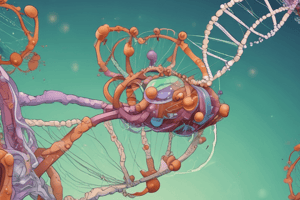Podcast
Questions and Answers
What is the physical structure of DNA?
What is the physical structure of DNA?
- Single strand
- Circular structure
- Double helix (correct)
- Triple helix
Which enzyme is primarily involved in DNA replication?
Which enzyme is primarily involved in DNA replication?
- Helicase
- DNA polymerase (correct)
- Topoisomerase
- RNA polymerase
What are genes composed of?
What are genes composed of?
- Chromosomes
- RNA molecules
- Sequences of DNA (correct)
- Proteins
What are the subunits of DNA called?
What are the subunits of DNA called?
What specifies the amino acids that make up proteins?
What specifies the amino acids that make up proteins?
What is an alteration of genetic material called?
What is an alteration of genetic material called?
What is the process by which DNA template synthesizes RNA, thus forming messenger RNA (mRNA)?
What is the process by which DNA template synthesizes RNA, thus forming messenger RNA (mRNA)?
Which molecule has an attachment site for a specific amino acid and an anticodon, a region that matches up with a 3-base codon on the mRNA?
Which molecule has an attachment site for a specific amino acid and an anticodon, a region that matches up with a 3-base codon on the mRNA?
What is the visual representation of an individual's chromosome karyotype?
What is the visual representation of an individual's chromosome karyotype?
What are the excised sequences from the mRNA called?
What are the excised sequences from the mRNA called?
Which type of cells have the normal number of chromosomes?
Which type of cells have the normal number of chromosomes?
What is a condition in which a cell has some multiple of the normal number of chromosomes?
What is a condition in which a cell has some multiple of the normal number of chromosomes?
What are the remaining pair of chromosomes in humans, after the twenty-two pairs of autosomes?
What are the remaining pair of chromosomes in humans, after the twenty-two pairs of autosomes?
What are DNA sequences with particularly high mutation rates called?
What are DNA sequences with particularly high mutation rates called?
Which molecule directs the synthesis of polypeptides during translation?
Which molecule directs the synthesis of polypeptides during translation?
What process involves ribonucleic acid (RNA) and results in the formation of messenger RNA (mRNA)?
What process involves ribonucleic acid (RNA) and results in the formation of messenger RNA (mRNA)?
Flashcards are hidden until you start studying
Study Notes
- Genes, the fundamental units of inheritance, are constructed of DNA sequences and are positioned on chromosomes.
- Each nucleotide, a DNA subunit, is made up of one deoxyribose, a phosphate molecule, and one of four nitrogenous bases. The physical form of DNA is a double helix. Nitrogenous bases in each strand pair up: thymine with adenine and guanine with cytosine.
- DNA's four bases encode for amino acids, protein building blocks. Amino acids are specified by triplet sets of nitrogenous bases called codons. Several codons represent the same amino acid.
- DNA replication is based on complementary base pairing. A single DNA strand acts as a template for creating a new strand. DNA polymerase, the primary enzyme, adds bases and performs proofreading functions.
- Mutations are alterations of genetic material resulting from base pair substitutions or frameshift mutations. Mutagens are substances causing mutations.
- Transcription and translation, processes specifying proteins using DNA, involve RNA. RNA shares similarities to DNA but is single-stranded, has a ribose sugar molecule, and uracil as one nitrogenous base instead of thymine.
- Transcription is the process of creating RNA from a DNA template, forming messenger RNA (mRNA). Much of the RNA sequence is spliced before mRNA leaves the nucleus.
- Translation is the process of RNA guiding protein synthesis in ribosomes. Ribosomes consist of proteins and ribosomal RNA.
- Human cells consist of diploid somatic cells (46 total chromosomes) and haploid gametes (23 total chromosomes). Humans have 23 pairs of chromosomes, 22 autosomes and 1 sex chromosome pair.
- A karyogram displays chromosomes in order based on length and centromere location, representing the individual's chromosome makeup. Chromosome stains can make bands more visible for identification and variation detection.
- Approximately 1 in 150 live births have major diagnosable chromosome abnormalities, known leading causes of intellectual disability and miscarriage.
- Euploid cells have the normal number of chromosomes. Polyploidy is a condition with cells having some multiple of the normal number of chromosomes, observed in triploidy and tetraploidy, both lethal.
- Aneuploidy occurs when a cell doesn't have a multiple of 23 chromosomes.
Studying That Suits You
Use AI to generate personalized quizzes and flashcards to suit your learning preferences.




